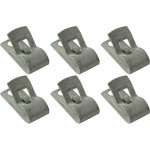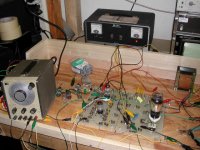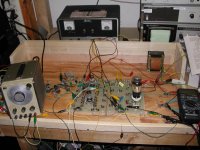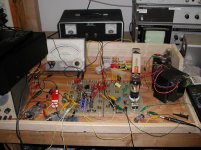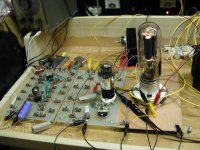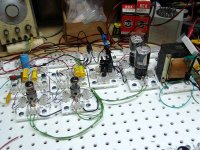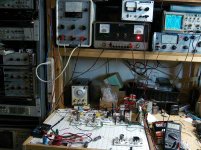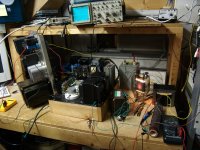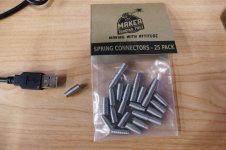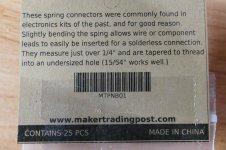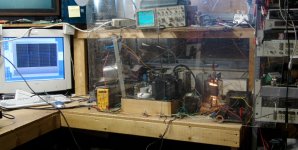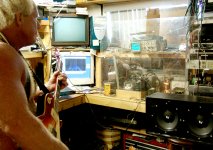Anyone remember this?
Anyone know where I can get springs like this? I want to use them in the same way but with test sockets
I found this, but it seems expensive for what it is really.... Tension Spring 0.3-0.8mm Expansion Extension Expanding Springs All Sizes 304 | eBay
Anyone know where I can get springs like this? I want to use them in the same way but with test sockets
I found this, but it seems expensive for what it is really.... Tension Spring 0.3-0.8mm Expansion Extension Expanding Springs All Sizes 304 | eBay
Attachments
Last edited:
And in my era we used Fahnestock clips.
https://www.amazon.com/School-Specialty-Science-Fahnestock-Clips/dp/B008C4S31Y
https://www.amazon.com/School-Specialty-Science-Fahnestock-Clips/dp/B008C4S31Y
Attachments
And in my era we used Fahnestock clips.
They take up a lot of room, especially when there are dozens of them.
Anyone remember this?
Anyone know where I can get springs like this? I want to use them in the same way but with test sockets
Try here: McMaster-Carr
jeff
Anyone remember this?
I had an electronics experimenters kit like that somewhere around 1960. It was made (or sold) by GE and featured germanium transistors like the 2N107. That's where I really learned what bias, impedance and other nifty electronics terms meant.
I have been searching for those springs ever since......until about 4 years ago they appeared in Sparkfun's web store. Unfortunately, most breadboarders didn't realize how neat these things are, or even what they are, so they vanished from their store within a year.
They did leave behind this:
Spring Connectors (pack of 10) - PRT-11822 - SparkFun Electronics
Recreating Classic Electronics Kits - learn.sparkfun.com
I did buy some, but not enough to make a new vacuum tube breadboarding tool like Tubelab 1, 2 or 3.
I have not been able to find them since either. If you do find these, let us know here.
I actually had this one: Electronic project kits: hands on with a vintage 160-in-1
I'm going to go to a hardware store today and see what I can find.
I'm going to go to a hardware store today and see what I can find.
This post awakened my curiosity and sparked a serious Google scavenger hunt......
I think I'll order some of these:
RadioShack(R) Science Fair-Style Spring Terminals - Pack of 25 – Maker Trading Post
I think I'll order some of these:
RadioShack(R) Science Fair-Style Spring Terminals - Pack of 25 – Maker Trading Post
I have been searching for those springs ever since......until about 4 years ago they appeared in Sparkfun's web store. Unfortunately, most breadboarders didn't realize how neat these things are, or even what they are, so they vanished from their store within a year.
Perhaps they realized modern breadboards are even neater? And that modern components come on a 0.1" pitch?
Perhaps they realized modern breadboards are even neater?
And for 99% of the new "maker movement" builders They are the right tool for the job. I have several and have even used them for some small vacuum tube prototypes.....but for those of us who build things with big parts, or a mixture of big and little parts, they are like trying to fix your car with a $20 tool kit that comes in a plastic case.
And that modern components come on a 0.1" pitch?
And Amazon stocks all sorts of nifty SMD adapters for those parts that come in less than 0.1'' pitch....but sadly no adapters for big stuff, so I made my own.
Back in high school we had "DeVry boards." They probably originated with the electronics school of the same name, but I can't find one on the web. They were much like the white plastic boards of today, but much bigger, maybe 12 inches by 18 inches. The wire holes were in groups of 5 like today's boards, but spaced about 1/2 inch apart, and could accommodate a 1 watt carbon comp resistor lead.....Yes, there were plug in tube sockets. Our power supplies went to 400 volts, and I was known to wire two or more of them together.
And in my era we used Fahnestock clips.
The name Tubelab came from the vacuum tube breadboarding system I created back around year 2000. It was a system of PC boards, one per stage, with Fahnestock clips for each component and board to board connections.
The idea sprang up from the Philco Educational Electronics racks that I had used in a 3 year vocational electronics program in high school (1967-1970). This used a rather large rack mounted module for each stage of an electronic project. A vacuum tube radio with 6 tubes took up an entire 19 inch rack that was 3 feet tall. Each component used thumb screws to attach it to the chassis.
I needed to make something that fit my bench top, so the Tube Lab was born. it was a huge improvement over the rack, but still too big. A more manageable and easily reconfigurable TubeLab was needed, so Tubelab 2 was created. It was smaller and had a plywood base with a grounded copper screen for shielding. A case with a closing lid was started, but never finished.
The subtle beginnings of what is now the Tubelab TSE and new TSE-II amplifiers can be seen here along with my 845SE.....yes I ran over 1000 volts through this thing. Little white plastic thingies need not apply.....
This was a huge improvement over the Philco rack from my youth, but not good enough, so I scrapped it all saving only the wood base which was used for Tubelab 3. I was walking through a Lowes home improvement store one day when I saw some white plastic pegboard. The base for my 1960's GE kit was wood pegboard with plug-able springs like the ones that this thread was about. I bought a piece, and went on to create Tubelab 3. Unfortunately the spring thingies were nowhere to be found, so I made modules and tie strips using screw in "Euro-Strips" from Radio Shack. it can be seen here abusing some 6AV5's in screen drive. This was the best Tubelab yet, but I was still not happy with it.
In 2014 I left my 41 year engineering career and had to move 1200 miles with three weeks notice. In the hectic moments of figuring out what to take, what to give away, and what to trash, many things were lost. The white plastic and wood base is here, all the individual modules are not.......Time for Tubelab 4. I was never happy with those screw terminal "Euro Strips." Loose or intermittent connections were common especially when several wires of different sizes were inserted......will the spring thingies work better?
I ordered some of those I found to find out. The individual modules will be made on PC board or perf board from Amazon.
Attachments
"hook up wire, single strand"
I tend to go for the "12 for $4" cheap clip leads. They often make for cheap, and smelly fuses when things go really wrong too.
Cheap alligator clip leads were good for about 80 v, not safe for tube projects. They used to be the only thing I would buy from Radio Shack. But they are gone, nearest Fry's is 165 miles away, mcmelectronics had some but newark dropped that item when they closed the warehouse & moved stock to SC. Too likely to be sued by some idiot that used them on 480 v 3 phase. Fluke makes some alligator clips that fit on meter probe, are about $25 each, rated 400 v, and perfectly useless for electronics because the insulation is so huge.Cheap croc clip leads are usually no good for any current, often badly crimped/soldered, wire super-fine. Signal use only...
A friend at my volunteer job (installing pipe organ) found some cheap alligator clips recently at harbor freight. May be the only thing I buy from that purveyor of imitation tools. I'm using one now to probe a surface mount PV8 mixer, why is the left channel silent on 8 inputs? Component lead in an alligator clip is my probe, cheap clip to ring of a RCA jack is my ground point. .47 uf cap in series with meter negative using 2 alligator clips. (answer, music disappears on left in filter area each channel )
Last edited:
Cheap alligator clip leads were good for about 80 v, not safe for tube projects.
Safety is highly dependent on the care, skill and knowledge of the user. I look at the cheap clip leads as if they were bare wire. There is 1500 volts in that yellow one. For all but this picture, there was a 1/4 inch thick piece of Lexan between the test amp and the user (me). Nobody else, nor the cats would come in the room while I was working.
now that I have the possibility of young grandkids appearing at any time without notice, the 845SE amp that was used to construct this test amp is kept out of site and hasn't seen power in 5 years.
Back to the regularly scheduled broadcast....
These little springie thingies showed up in the mail today....they are exactly what I have been looking for and far nicer than the ones Sparkfun discontinued.
Attachments
These little springie thingies showed up in the mail today....they are exactly what I have been looking for and far nicer than the ones Sparkfun discontinued.
Fancy, with a nice little taper to them.

jeff
1/4 lexan molten metal shield! I'm impressed.Safety is highly dependent on the care, skill and knowledge of the user. I look at the cheap clip leads as if they were bare wire. There is 1500 volts in that yellow one. For all but this picture, there was a 1/4 inch thick piece of Lexan between the test amp and the user (me). Nobody else, nor the cats would come in the room while I was working.
1/4 lexan molten metal shield! I'm impressed.
Transparent Aluminum.........(Star Trek)
The "blast shield" was in place for all cases where the test was running. That big cap was removed from a defibrillator. I learned what kind of energy storage it could hold........never put a defib across a banana and hit the button.
It was also to prevent accidental contact with DEADLY voltages especially with a guitar. Even though the guitar is grounded through it's cord......Mr. Storage can blow a guitar cord in half with plenty of deadly power left!
Attachments
- Status
- This old topic is closed. If you want to reopen this topic, contact a moderator using the "Report Post" button.
- Home
- Design & Build
- Parts
- 60-in-1 electronics kit springs...

